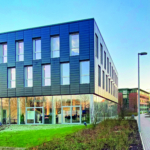Blue-green instead of Brown
A climate-resilient city needs intact green spaces. The Smart Green City pilot project uses intelligent sensors to ensure that these areas will always be sufficiently watered. By Ulrike Bohnsack
Too warm, too dry – this is how most months are these days. As a result, urban green spaces suffer and need to be watered more than ever. This is why: ‘When natural and near-natural areas turn brown, it doesn’t just look unattractive. It also has serious consequences,’ warns Prof. Dr. André Niemann from the UDE Institute of Hydraulic Engineering and Water Resources Management. ‘The blue-green infrastructure – by which we mean plants, soils and water cycles – provides recreation for us humans and habitats for animals. It filters and cools the air and can absorb a lot of rain like a sponge. But if the soil is parched, water can no longer seep away in case of heavy rain.’
Keeping the green in good shape and water consumption low: Niemann and three environmental technology and IT companies have launched the Smart Green City* project with this goal in mind. For this purpose, a large-scale field trial has been running in Bochum since January. 50 intelligent sensors have been installed on premises owned by two housing associations to monitor plant growth and the soil-water balance until the end of March 2023. The sensors are ‘blue, round discs about 10 centimetres in size,’ as Niemann describes the measuring devices. ‘They’re designed for the Internet of Things (IoT) and utilise artificial intelligence. As a result, they communicate wirelessly, can interpret the collected data and transmit it to the network of Bochum public utilities.’
The IoT sensors are inserted into the ground or buried up to 1.50 metres deep. Here, in addition to soil moisture and temperature, they measure other important parameters, such as the ability to absorb and store water; whereas above-ground sensors determine the water level in streams and cisterns. On top of that, the sensor data is supplemented with weather forecasts. If the water level falls below certain values, this will be reported to an automatically controlled rainwater cistern, which releases water in a controlled manner. ‘Part of the field test is also an underground drainage and retention system. To this end, water reservoirs were created under street trees and connected to each other. When it rains, the water flows into these trenches. As a result, plant roots can take care of themselves when it is too dry, and the strain on the sewage system is reduced.’
Such modern systems can’t simply be retrofitted, of course. This is why plans exist to create a citizens’ platform to monitor how well the urban nature is supplied. If necessary, committed citizens and initiatives will then be able to grab the watering can. And if the need in the area is too great, the competent authorities will receive a message that they should move in with heavy equipment.
In order to become climate resilient, i.e. to prepare themselves for the consequences of extreme weather, municipalities still have a long way to go. André Niemann believes that this will include intelligent percolation and irrigation in all urban planning processes and in the construction of new residential areas. Or to put it another way: Smart cities are green.
* Smart Green City is funded by the EU as part of the REACT-EU initiative. The consortium leader is Okeanos Smart Data Solutions GmbH.
Partners include the UDE Institute of Hydraulic Engineering and Water Resources Management, Auto-Intern GmbH and PHYSEC GmbH.



